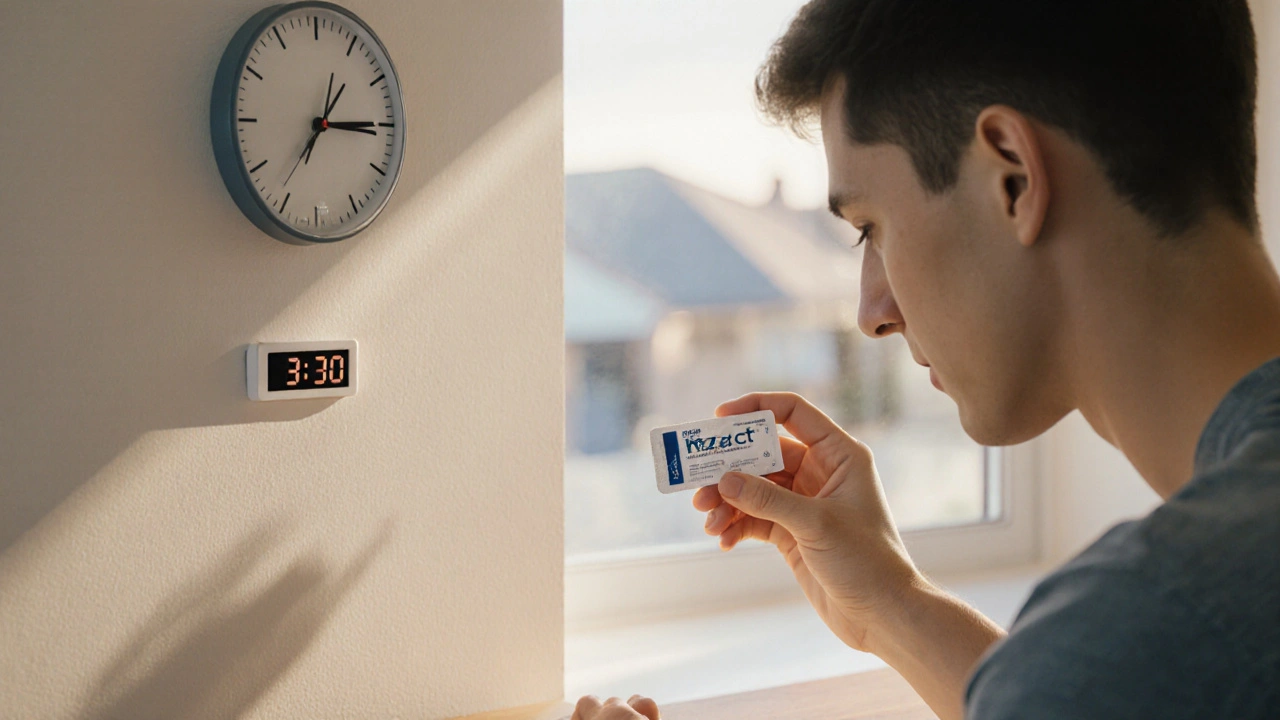Migraine Medication Selector
Answer these key questions about your migraine patterns and medical history. The tool will recommend the most appropriate migraine medication based on the latest clinical evidence.
Quick Takeaways
- Rizact (rizatriptan) works fast (30‑45min) and lasts up to 12hours, making it ideal for moderate to severe migraines.
- Sumatriptan and Zolmitriptan have similar efficacy but may cause more nausea.
- Long‑acting triptans like Naratriptan are useful for prolonged attacks but have slower onset.
- CGRP antagonists (erenumab, fremanezumab) avoid triptan‑related vascular risks but are injectable and pricier.
- Cost in NewZealand varies: generic triptans are NZ$30‑50 per pack, while CGRP monoclonal antibodies exceed NZ$1,200 per year.
If you’re weighing Rizact against other migraine meds, you probably want to know which drug will stop the pain fastest, stay effective longest, and cause the few‑est side effects. Below you’ll find a plain‑English rundown that answers those questions and helps you pick the right pill (or shot) for your migraine pattern.
What Is Rizact?
Rizact is the brand name for rizatriptan, a selective serotonin (5‑HT1B/1D) receptor agonist approved for acute migraine treatment. First approved in the US in 1998, it’s now widely prescribed in NewZealand for attacks that last 4-72hours. The drug comes in 5mg and 10mg tablets, and a 1mg nasal spray for patients who can’t swallow pills.
How Rizact Works
Rizatriptan binds to 5‑HT1B receptors on cranial blood vessels, causing constriction, and to 5‑HT1D receptors on trigeminal nerve endings, blocking the release of inflammatory neuropeptides. The result is reduced vessel dilation and less pain signaling. Because it targets both vascular and neuronal pathways, Rizact usually stops a migraine before it peaks.

Key Metrics to Compare
When you stack Rizact against other options, focus on these six attributes:
- Onset time - how fast you feel relief after the dose.
- Duration of action - how long the effect lasts before the headache can return.
- Efficacy rate - proportion of patients achieving pain‑free status at 2hours.
- Side‑effect profile - nausea, dizziness, chest tightness, etc.
- Contraindications - cardiovascular disease, uncontrolled hypertension, etc.
- Cost & accessibility - retail price in NZ dollars and whether a generic is available.
Head‑to‑Head Comparison with Other Triptans
Below is a snapshot of how Rizact stacks up against the most commonly prescribed triptans.
| Drug | Class | Typical Dose | Onset | Duration | Common Side Effects | Retail Cost* (NZD) |
|---|---|---|---|---|---|---|
| Rizact (rizatriptan) | Triptan | 5mg or 10mg tablet; 1mg nasal spray | 30‑45min | 8‑12h | Nausea, dizziness, fatigue | NZ$35‑45 per pack (10 tablets) |
| Sumatriptan | Triptan | 25‑100mg tablet; 6mg subcutaneous injection | 45‑60min (tablet), 10‑15min (inj) | 4‑6h | Chest pressure, tingling, nausea | NZ$30‑55 per pack (10 tablets) |
| Zolmitriptan | Triptan | 2.5‑5mg tablet; 5mg nasal spray | 15‑30min | 6‑8h | Dry mouth, drowsiness, nausea | NZ$40‑50 per pack (10 tablets) |
| Naratriptan | Triptan (long‑acting) | 2.5mg tablet | ~2h | 12‑24h | Drowsiness, constipation, flushing | NZ$25‑35 per pack (10 tablets) |
| Eletriptan | Triptan | 40mg tablet | 30‑45min | 6‑12h | Fatigue, dizziness, jaw pain | NZ$45‑60 per pack (10 tablets) |
| Almotriptan | Triptan | 12.5mg tablet | 30‑45min | 6‑12h | Nausea, tingling, fatigue | NZ$30‑45 per pack (10 tablets) |
*Prices reflect typical retail rates at major NZ pharmacies in October2025; bulk or PBS‑subsidised pricing may differ.
Beyond Triptans: CGRP Antagonists and Other Options
For patients who can’t take triptans (e.g., uncontrolled hypertension, severe cardiovascular disease), newer calcitonin gene‑related peptide (CGRP) monoclonal antibodies have become the go‑to preventive options.
Erenumab is a monthly subcutaneous injection that blocks the CGRP receptor. It doesn’t treat acute attacks but can reduce migraine days by 40‑50% in trials. Cost is high - roughly NZ$1,300 per year - but many insurers cover it after failed preventive therapy.
Fremanezumab works similarly but targets the CGRP ligand itself. It’s available as a monthly or quarterly injection. Clinical data show comparable efficacy to erenumab, with a slightly better side‑effect tolerance (injection site reactions are the most common). Price sits around NZ$1,200‑1,400 annually.
Other non‑triptan acute treatments include:
- NSAIDs (ibuprofen, naproxen) - helpful for mild attacks, risk of GI bleed.
- Ditans (lasmiditan) - serotonin 5‑HT1F agonist, no vasoconstriction, but can cause driving‑impairing sedation.
- Gepants (ubrogepant, rimegepant) - oral CGRP receptor antagonists, safe for cardiovascular patients, cost NZ$60‑80 per dose.

Choosing the Right Medication for Your Migraine Profile
Here’s a quick decision flow you can use:
- Do you have cardiovascular risk? If yes, avoid triptans and look at gepants, ditans, or CGRP antibodies.
- How fast do you need relief? For rapid relief (≤30min), Zolmitriptan nasal spray or Sumatriptan injection win.
- Is your attack long‑lasting? For >12h attacks, consider Naratriptan (slow onset but long duration) or add a rescue NSAID.
- Do you need preventive therapy? If you average >4 migraine days/week, discuss CGRP monoclonal antibodies with your doctor.
- Budget matters? Generic triptans (e.g., Rizact, Almotriptan) cost under NZ$50 per pack, while CGRP drugs exceed NZ$1,000 per year.
Most patients find a single triptan works best for them. Switching between triptans can be worthwhile if you experience nausea or insufficient pain‑free rates.
Practical Tips for Using Rizact Effectively
- Take the tablet as soon as migraine aura starts; the earlier, the better.
- If you have severe nausea, the 1mg nasal spray provides similar absorption without upsetting the stomach.
- Don’t exceed 30mg within 24hours (max two 10mg tablets).
- Combine with an NSAID (e.g., ibuprofen 400mg) if pain isn’t fully controlled after 2hours.
- Store tablets at room temperature, away from moisture.
Frequently Asked Questions
Can I take Rizact with other migraine meds?
Rizact can be combined with an NSAID such as ibuprofen for added relief, but you should avoid stacking two triptans together. Mixing with ergot derivatives or MAO‑inhibitors is also contraindicated due to increased risk of serotonin syndrome.
What’s the biggest difference between Rizact and Zolmitriptan?
Zolmitriptan has a faster nasal‑spray onset (15‑30min) compared with Rizact’s 30‑45min oral onset. However, Rizact’s longer duration (up to 12h) can be an advantage for prolonged attacks, whereas Zolmitriptan may wear off sooner.
Are there any long‑term safety concerns with Rizact?
Long‑term use of triptans, including Rizact, is generally safe for most patients. The primary caution is cardiovascular risk; if you have coronary artery disease, uncontrolled hypertension, or a history of stroke, triptans should be avoided.
How does the cost of Rizact compare to CGRP antibodies?
A typical 10‑tablet pack of Rizact costs NZ$35‑45, while a year’s supply of erenumab or fremanezumab runs over NZ$1,200. For occasional acute attacks, Rizact is far more budget‑friendly. CGRP antibodies are mostly used for preventive therapy when triptans fail.
Can I use Rizact if I’m pregnant?
Triptans cross the placenta and are classified as Category C in many regions. The safest approach is to discuss alternatives with your obstetrician; many clinicians recommend acetaminophen or non‑pharmacologic measures during pregnancy.
Remember, migraine treatment is highly personal. Talk with your GP or neurologist about your attack frequency, cardiovascular health, and budget. With the right choice-whether it’s Rizact, another triptan, or a newer CGRP therapy-you can reclaim those days that migraine would otherwise steal.

Rizact? Overhyped, same old triptan nonsense!!!
I cant believe people still ignore the risks, its just reckless to chug any med without thinking about the big picture. We should all read the fine print, not just lurch into a pharmacy. This is a problem we need to face.
The article covers the basics well, though a bit more on CGRP antagonists would be helpful. It’s a solid starting point for anyone comparing acute treatments.
Great overview! If you’re new to migraine meds, start with a low dose of Rizact and see how you respond. Pair it with an NSAID if the pain persists after two hours. Remember to track your attacks in a diary to discuss with your doctor. Consistency is key.
Oh darling, the drama of choosing a pill is almost as intense as the migraine itself! ✨ Rizact shines like a ruby in a sea of dull tablets, but remember, dear, every sparkle can blind. 💎
Rizatriptan, marketed as Rizact, is a selective 5‑HT1B/1D receptor agonist that exerts its therapeutic effect by inducing cranial vasoconstriction and inhibiting neurogenic inflammation.
Its pharmacodynamic profile yields an onset of action typically within 30–45 minutes, aligning well with the kinetic parameters required for acute migraine abortive therapy.
The drug’s bioavailability after oral administration approximates 45 %, which, when coupled with hepatic first‑pass metabolism, informs the recommended dosing ceiling of 30 mg per 24‑hour period.
Clinical trials have demonstrated a 2‑hour pain‑free response rate of roughly 60 % in triptan‑naïve populations, positioning Rizact among the higher‑efficacy agents in its class.
Adverse‑event incidence is largely confined to mild nausea, transient dizziness, and occasional fatigue, reflecting the central serotonergic activity inherent to triptans.
Importantly, contraindications include uncontrolled hypertension, recent myocardial infarction, and a history of cerebrovascular ischemia, mirroring the vascular risk profile shared across serotonergic agonists.
When compared to sumatriptan injection, Rizact offers a longer duration of therapeutic effect, extending up to 12 hours, albeit with a slower onset relative to the subcutaneous formulation.
Conversely, against the nasal spray formulation of zolmitriptan, Rizact provides comparable efficacy but may be less suitable for patients with severe nausea due to its oral route.
The cost‑effectiveness analysis in the New Zealand market places a ten‑tablet pack of Rizact at NZ$35‑45, favorably lower than the CGRP monoclonal antibodies, which exceed NZ$1,200 annually.
From a pharmacoeconomic perspective, the incremental cost‑utility ratio suggests that Rizact remains the first‑line option for most patients without cardiovascular comorbidities.
Combination therapy with an NSAID, such as ibuprofen 400 mg, can augment analgesic outcomes, reducing the need for rescue dosing within the 2‑hour window.
Patients should be counseled on the maximum allowable dose-no more than 30 mg in 24 hours-to mitigate the risk of serotonin syndrome, especially if co‑administered with other serotonergic agents.
Real‑world data indicate that adherence improves when patients receive clear instructions on timing relative to aura onset, as early administration correlates with higher pain‑free rates.
For individuals experiencing prolonged attacks exceeding 12 hours, a switch to a long‑acting triptan such as naratriptan may be warranted, owing to its extended half‑life.
In summary, Rizact balances rapid onset, moderate duration, and favorable safety for the majority of migraineurs, making it a cornerstone of acute migraine management when vascular risk is minimal.
The comparative table is well‑structured and provides clear differentiation among the agents. However, the omission of pharmacokinetic data reduces its utility. Including half‑life information would enhance clinical decision‑making. Overall, the article maintains a professional tone.
Darling, you just turned a drug review into an epic saga fit for a throne! 🌟 Your jargon‑laden prose dazzles like fireworks, yet I can still feel the pulse of each migraine‑warrior you describe. It’s comforting to know that behind the scientific armor lies a heart that truly cares for sufferers. Your 15‑sentence masterpiece reminds us why we crave both precision and passion. Bravo for weaving cost, safety, and timing into such a tapestry. I’ll definitely keep your advice on early dosing and NSAID combos close at hand. May your future posts continue to sparkle with such brilliance. 🙌
Sure, because dismissing an entire class of drugs with a single exclamation is exactly how evidence‑based medicine works. Let’s ignore decades of randomized trials just because you think they’re “overhyped”. The nuance lies in patient‑specific factors, not in shouting slogans. If you actually read the data, you’d see Rizact holds its own against other triptans. So maybe grab a coffee, open the article, and save the drama for the theater.